I am trying logistic regression using gradient descent with two data set, I get different result for each of them.
Dataset1 Input
X=
1 2 3
1 4 6
1 7 3
1 5 5
1 5 4
1 6 4
1 3 4
1 4 5
1 1 2
1 3 4
1 7 7
Y=
0
1
1
1
0
1
0
0
0
0
1
Dataset2 input-
x =
1 20 30
1 40 60
1 70 30
1 50 50
1 50 40
1 60 40
1 30 40
1 40 50
1 10 20
1 30 40
1 70 70
y =
0
1
1
1
0
1
0
0
0
0
1
The difference in dataset 1 and dataset2 is only the range of values. When I run my common code for both the data set,, My code gives desired output for dataset one but very weird idea for dataset 2.
My code goes as follow:
[m,n]=size(x);
x=[ones(m,1),x];
X=x;
%3. In this step we will plot the graph for the given input data set just to see how is the distribution of the two class.
pos = find(y == 1); % This will take the postion or array number from y for all the class that has value 1
neg = find(y == 0); % Similarly this will take the position or array number from y for all class that has value 0
% Now we plot the graph column x1 Vs x2 for y=1 and y=0
plot(X(pos, 2), X(pos,3), '+');
hold on
plot(X(neg, 2), X(neg, 3), 'o');
xlabel('x1 marks in subject 1')
ylabel('y1 marks in subject 2')
legend('pass', 'Failed')
hold off
% Now we limit the x1 and x2 we need to leave or skip the first column x0 because they should stay as 1.
% The critical thing hear to know is that this is not a linear regression but logistic regression, hence the h(hypothesis varies)
% So we calculate the hypothesis that is based on e
% j_theta will be calculated upon all the training set for 1st iteration
%
g=inline('1.0 ./ (1.0 + exp(-z))');
alpha=1;
theta = zeros(size(x(1,:)))'; % the theta has to be a 3*1 matrix so that it can multiply by x that is m*3 matrix
max_iter=2000;
j_theta=zeros(max_iter,1); % j is a zero matrix that is used to store the theta cost function j(theta)
for num_iter=1:max_iter
% Now we calculate the hx or hypothetis, It is calculated here inside no. of iteration because the hupothesis has to be calculated for new theta for every iteration
z=x*theta;
h=g(z); % Here the effect of inline function we used earlier will reflect
h
j_theta(num_iter)=(1/m)*(-y'* log(h) - (1 - y)'*log(1-h)) ; % This formula is the vectorized form of the cost function J(theta) This calculates the cost function
j_theta
theta = theta - (alpha/m) * x' * (1./(1+exp(-x*theta)) - y);
%grad=(1/m) * x' * (h-y); % This formula is the gradient descent formula that calculates the theta value.
%theta=theta - alpha .* grad; % Actual Calculation for theta
theta
end
figure
plot(0:1999, j_theta(1:2000), 'b', 'LineWidth', 2)
hold off
figure
%3. In this step we will plot the graph for the given input data set just to see how is the distribution of the two class.
pos = find(y == 1); % This will take the postion or array number from y for all the class that has value 1
neg = find(y == 0); % Similarly this will take the position or array number from y for all class that has value 0
% Now we plot the graph column x1 Vs x2 for y=1 and y=0
plot(X(pos, 2), X(pos,3), '+');
hold on
plot(X(neg, 2), X(neg, 3), 'o');
xlabel('x1 marks in subject 1')
ylabel('y1 marks in subject 2')
legend('pass', 'Failed')
plot_x = [min(X(:,2))-2, max(X(:,2))+2]; % This min and max decides the length of the decision graph.
% Calculate the decision boundary line
plot_y = (-1./theta(3)).*(theta(2).*plot_x +theta(1));
plot(plot_x, plot_y)
hold off
Please find the graph for each data sets as follow:
For data set 1:

For dataset2:

As you can see data set one gives me correct answer.
Having said that I believe the datsaet2 has wide range of data probably 10-100, Hence to normalize it I used feature scaling with the dataset2 and got the graph. The decision line formed was correct but a bit below the expected place, see it for yourself.
Dataset2 input with feature scaling:
x =
1.00000 -1.16311 -0.89589
1.00000 -0.13957 1.21585
1.00000 1.39573 -0.89589
1.00000 0.37219 0.51194
1.00000 0.37219 -0.19198
1.00000 0.88396 -0.19198
1.00000 -0.65134 -0.19198
1.00000 -0.13957 0.51194
1.00000 -1.67487 -1.59981
1.00000 -0.65134 -0.19198
1.00000 1.39573 1.91977
y =
0
1
1
1
0
1
0
0
0
0
1
The graph I get after adding feature scaling to my previous code is given below

As you can see if the decision line was a bit up then I would have got the perfect output..
Please help me understand the scenario, why even feature scaling cant help. or if my code has some error,, or if I am missing anything.